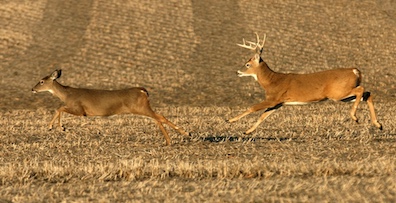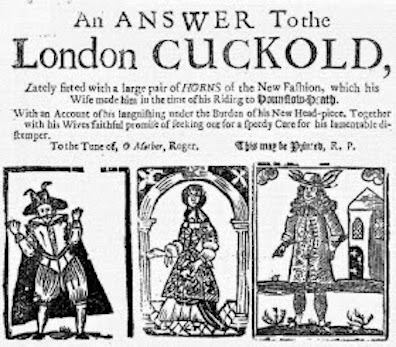Tragic, "hornmad" bitterness characterizes men like Leontes,
the jealous husband of The Winter's Tale:
Inch-thick, knee-deep; o’er head and ears a
fork’d one.
Go, play, boy, play: thy mother plays, and I
Play too; but so disgrac’d a part, whose issue
Will hiss me to my grave: contempt and clamour
Will be my knell. Go, play, boy, play. There have been,
(Or I am much deceiv’d) cuckolds ere now,
And many a man there is (even at this present,
Now, while I speak this) holds his wife by th’ arm,
That little thinks she has been sluic’d in’s absence
And his pond fish’d by his next neighbour, by
Sir Smile, his neighbour. (1.2.186-96)
Rosalind presents the fear comically in As You Like It when
she tells Orlando that she would rather be wooed by a snail,
who "brings his destiny with him"––i.e., "horns! which such
as you are fain to be beholding to your wives for. But
he comes arm'd in his fortune, and prevents the slander of his
wife" (4.1.57-62). In the final scene of Much Ado
about Nothing, where the two romantic couples come
together at last, Claudio lays his fear of infidelity at
Benedick's door: "I think he thinks upon the savage bull. /
Tush, fear not, man, we'll tip thy horns with gold, /
And all Europa shall rejoice at thee, / As once Europa did at
lusty Jove, / when he would play the noble beast in love"
(5.4.43-47). After both couples plight troth, Benedick
proposes a dance "that we may lighten our own hearts and our
wives' heels," and he urges Don Pedro too to find a
wife: "There is no staff more reverent than one tipp'd
with horn" (118-24).
In Scylla and Charybdis Stephen imagines Shakespeare
trying to compensate for his humiliation in Stratford by
playing the rake in London: "You know Manningham's story of
the burgher's wife who bade Dick Burbage to her bed after she
had seen him in Richard III and how Shakespeare, overhearing,
without more ado about nothing, took the cow by the horns
and, when Burbage came knocking at the gate, answered from the
capon's blankets: William the conqueror came before
Richard III." The thought of Will jumping into a married
woman's bed here echoes Much Ado's jokes about
cuckoldry as an inevitable side effect of marriage. (It also
seems possible that when Stephen imagines him "overhearing"
plans for an adulterous liaison he is recalling the
eavesdropping that drives the play's tragic subplot.)
Two chapters later, Sirens uses horns in an different
but clearly related way. The introductory list of themes
sounds the note twice, with "Horn. Hawhorn" and "Have
you the?" The OED cites a definition of "horn"
in Grose's Classical Dictionary of the Vulgar Tongue"
(1785) as "An erect penis; an erection," and it notes that by
1889 "horny" and "to have (also get) the horn" were being used
to mean "lustful, sexually aroused." Green's Dictionary of
Slang documents such use of "horny" in an American text
of 1826. These expressions were probably suggested by the
physical appearance of the erect penis, while the horns of
cuckoldry may have been inspired by the competition of male
deer for females. But even if the two uses did arise
independently, they become strongly linked in Joyce's story of
Boylan fucking Bloom's wife.
In Sirens, when Boylan suddenly bounces out of the
bar to jump in a cab (it is after 4:00), Lenehan
exclaims, "Got the horn or what?" The narrative later
picks up on his language, suggestively joining the horn with jingling,
heat, and female rumps: "By Bachelor's walk jogjaunty jingled
Blazes Boylan, bachelor, in sun in heat, mare's glossy rump
atrot, with flick of whip, on bounding tyres: sprawled,
warmseated, Boylan
impatience, ardentbold. Horn. Have you the? Horn.
Have you the? Haw haw horn." "Haw haw" suggests that
Bloom's cuckolding is all a great joke, as Lenehan would no
doubt say if he knew where Boylan was going. Bloom does know,
and he apparently has heard Lenehan's exclamation, because as
he writes Martha later in the chapter he thinks, "Write me a
long. Do you despise? Jingle, have you the? So
excited. Why do you call me naught? You naughty too? O, Mairy
lost the pin of her. Bye for today. Yes, yes, will tell you.
Want to. To keep it up." Still later
he thinks, "Hunter with a horn. Haw. Have you the?" Now
the narrator's "Haw haw" too has entered his thoughts.
With horn-as-phallus firmly linked with Bloom, Joyce applies
the cuckold's horns to him in Circe. As he steps over
the threshold of the whorehouse he sees a man's hat and
raincoat hanging on an "antlered rack" in the entrance
hall. He hesitates––another man in the house?––and averts his
eyes when a customer leaves a room and passes by. Later, in
hallucinatory fantasy, this momentary anxiety about entering a
house where another man is having sex blossoms into Bloom's
fullblown anxiety about Boylan entering the house on Eccles
Street. Reenacting Shakespeare's trick of showing up at a
willing wife's doorstep, Blazes Boylan is met at the door by
Bloom, attired in servant's livery and playing the part of a
compliant cuckold: "(He hangs his hat smartly on a peg
of Bloom's antlered head.) Show me in. I have a
little private business with your wife, you understand?"
After this scabrous fantasy reaches its climax, Joyce brings
the focus back to Shakespeare: "Stephen and Bloom gaze in
the mirror. The face of William Shakespeare, beardless,
appears there, rigid in facial paralysis, crowned by the
reflection of the reindeer antlered hatrack in the
hall." The Shakespearean theme of adultery is thus
mapped onto both Stephen and Bloom, the one perhaps because he
has discerned the central organizing principle of the Bard's
life and work, the other certainly because he is experiencing
the same agonizing marital drama.




